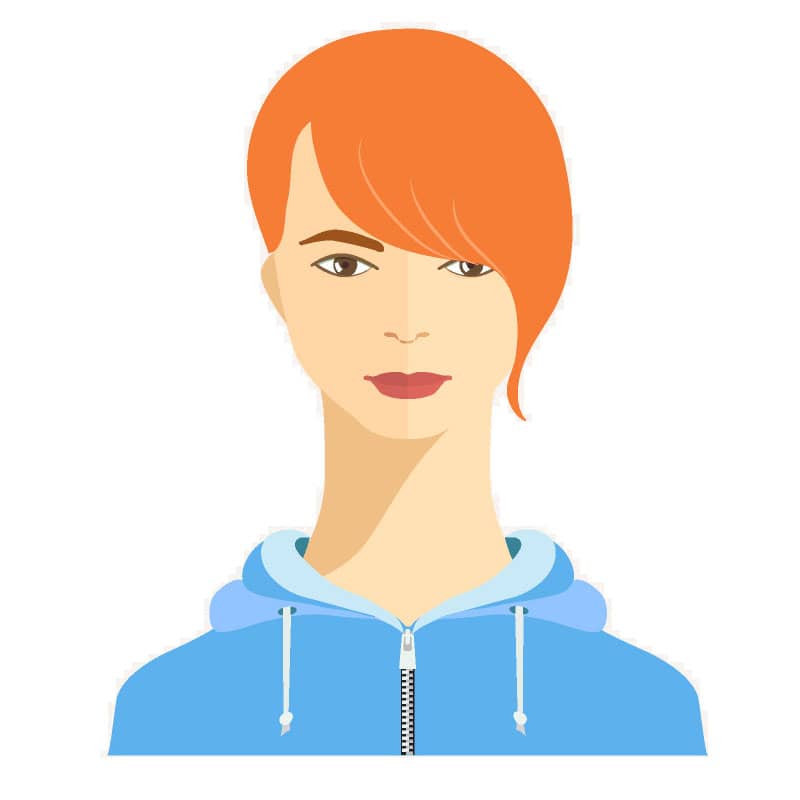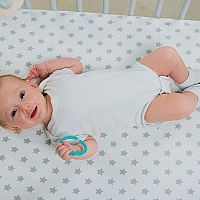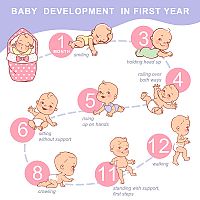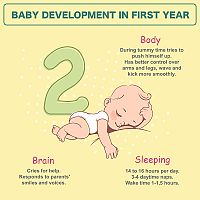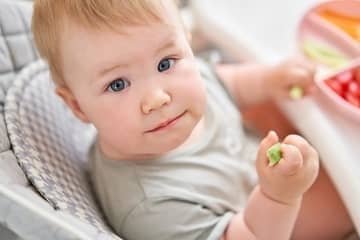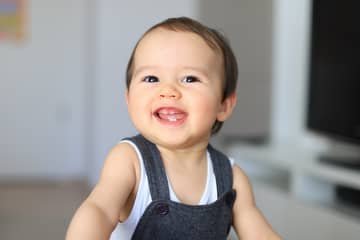
2-month-old baby (child) - development, diet, sleep, exercises, toys. See what it can do
The mother has only just returned from the maternity ward, and after a month she no longer has a newborn in front of her eyes, but a "big" infant. Just at the turn of the 1st and 2nd months, the baby no longer has the status of a newborn, but of an infant. It is also an important moment for a woman, because during the 2nd month (in the 6th week) the six-week period ends. The baby is constantly in the familiarization phase with the surrounding environment and all the stimuli around. However, there are other developments that define the two-month-old. Sleeping habits will most likely change, and behavior will also partially change, and the little one's communication tools will be enriched. What should a 2-month-old baby know?
During the 2nd month, the baby starts to be more interested in its surroundings. He begins to register other faces, moving objects, he can smile and, in terms of motor skills, he can finally control the movements of his limbs in a limited way. Between the ages of 2 and 5 months, a visit to an orthopedist is recommended. For the first time in this period, you can catch an attempt to communicate with "unidentifiable" speech. Even the first toys can have a more significant meaning. What a 2-month-old baby can do is very individual. Do not perceive individual characteristics and properties as necessary. Each child's development proceeds at a different pace.
What can a 2-month-old baby do?
During physical development, a two-month-old infant develops fine and gross motor skills as well as sensory perception. Compared to the first month, the child can already control the movements of his legs and hands to a limited extent. From the point of view of fine motor skills, when lying on the back, the palms are usually half-open or completely open, and the fingers are more flexible. Therefore, the child can hold an object in his hand for a short time. It is appropriate to stimulate his tactile senses. When lying on his stomach, he can raise his head and turn it in a specific direction. The movement of the head can now be isolated - it does not turn the chest and body, but only the head. Of course, to a limited extent.
The baby observes his hands and fingers. While lying on his back, he can direct his hands and fingers to his mouth and puts his fists in his mouth and licks them. There is also a joining of the right and left hands, which indicates the interaction of both hemispheres of the brain. He raises his legs in a position on his back above the mat and keeps them in the air for a while. The abdominal muscles are already strengthening. In the prone position, the baby may struggle to lean on his elbows and raise his head. The child controls the neck better and better. He tries to reach for objects - toys in his focal distance, but he still cannot grasp them perfectly. So it is one of the first deliberate movements with a clear intention that are controlled by the brain.
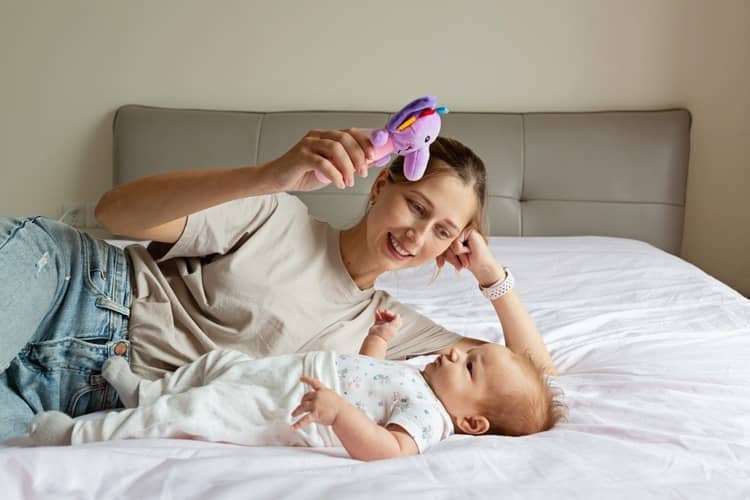
Speech and vision of a baby in the 2nd month
The child interacts much more with the environment. He has better observation ability, he follows dynamic movement and his vision improves. He still cannot coordinate his eye movements in one direction. That's why the baby can squint. The ability to coordinate the movement of the eyes appears only during the 3rd to 6th month. Then the squinting should stop. Otherwise, a diagnosis by an ophthalmologist is necessary. Peripheral vision also develops around 3-6 months. A baby's color vision is still not fully developed. The child can still see at a relatively short distance. However, the brain processes information about contours and shapes (recognizes edges). At close range, it recognizes faces or the shape of objects, such as toys.
Interaction, eye contact, touching, carrying on hands is required. In addition to crying, he begins to communicate with a smile and occasional grimaces. You often make him laugh with your smile and he smiles back. The child perceives sounds, not only voices, but also melodies, rattles and catches some voices. He can recognize the voices of his mother or father. A certain "type of speech" in a two-month-old baby can be considered cooing, winking and occasional guttural sounds resembling the vowels "ooooo" - "aaaah". Different intensity of crying can mean hunger, wet diaper or pain. If the sound indicates the baby, he tries to look for it with his eyes. Occasional idle babbling as if imitating human speech. He can also express joy and displeasure by moving his hands and feet. Due to the fact that there is a closer understanding, the child enjoys the attention and the waking states are extended.
Feeding and diet of a two-month-old baby
The basic component of food, even in the period of 2 months, is constantly represented by mother's milk or artificial milk. No additional feeding is necessary during this period, the child is sufficient with the rich nutrients offered by mother's milk. The feeding intervals in the table are more of a recommendation. It depends on how much milk the child drinks during the current breastfeeding. It is not possible to track it during breastfeeding and you should always feed the baby when it requires it. How often to feed a 2-month-old baby is therefore very individual. Feeding intervals can vary from 1 to 4 hours, at night the intervals can be longer. It depends on the set needs of the baby and his routine of the day.
Based on the charts, an infant gains around 20 to 30 grams per day in the 2nd month of age. This represents a weekly increase of 120 to 250 grams (note according to the tables of the World Health Organization - WHO). Even during this period, colic is a risk for infants, which is accompanied by long-lasting crying and restlessness, while the cause may not be completely obvious. The infant is thriving, gaining weight and has no symptoms of illness. In some cases, the cause is a stomach imbalance, flatulence, unsuitable artificial milk (can be accompanied by constipation or diarrhea), incorrect handling of the child or an allergic reaction. By the 3rd month, infant colic should subside. If you suffer from colic more often, consult your pediatrician. Probiotics for infants or fennel tea can be helpful.
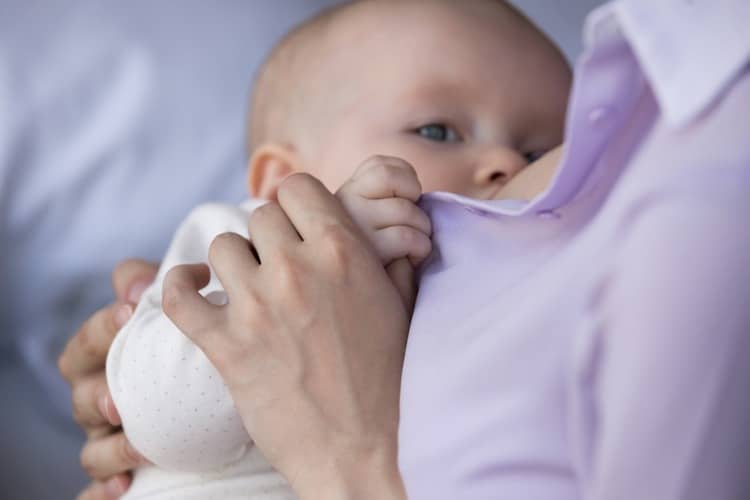
Lactation crisis
During the 6th to 8th week, a nursing mother may experience a period called a lactation crisis. This period is also characteristic in the 3rd to 5th month. A lactation crisis (note the mother's authentic story about the loss of milk) does not occur in every breastfeeding woman. This is a condition when the mother has a temporary lack of milk. It often happens that women, believing that they have lost milk, stop breastfeeding and switch to artificial formula. This temporary decrease in milk production usually subsides within a few days.
Often it is just the mother's inner feeling that there is a significant decrease in milk. Try to support the production of breast milk by putting the baby to the breast more often, sufficient fluid intake is necessary. In most cases, the breasts always produce as much milk as the baby sucks. It is not necessary for the breasts to be soft after each feeding. The subconscious also plays a role. According to some mothers, breast and nipple massage can help. Expressing or pumping milk from the point of view of lactation support is rejected by many, but in some cases, pumping milk after breastfeeding can help, because it is possible to store breast milk and use it during the lactation crisis.
Baby sleep and games
Compared to the first month, sleep and wakefulness intervals begin to lengthen. As the child becomes more receptive, the classic form of wake, change, bathe, feed and sleep no longer always works. Babies like to spend time awake because they observe their surroundings. They like to be carried on their hands, which, on the one hand, in combination with rocking, can be an effective tool for falling asleep. The night's sleep should be longer, but sometimes it's just wishful thinking. It is still true that repetitive rituals should be practiced before sleep, which will create a link in the child that it is time to sleep. An infant's biorhythm often changes. In the 2nd month, the baby can sleep 5 to 6 hours during the night, but it can easily be more or less. The need for sleep for a two-month-old baby is approximately 14 to 16 hours.
During the time when the child is awake, it is good to entertain and tire him. On the contrary, do not stimulate him too much before sleeping at night. The child does not yet distinguish between day and night. Establish a ritual, for example bathing the baby before bed. Some children sleep less during the day and sleep all through the night with occasional awakenings for a wet diaper or for feeding, while others have longer periods of sleep during the day and therefore have interrupted sleep at night. If the child's daytime sleep is longer than 3 hours, wake him up with a soft voice or gently caress his hands and feet.
Actively spend time with your baby by holding him in your arms. Make eye contact with the child. Read to him, sing to him and try to make him laugh. Spend time with him on the exercise mat, play with him, hold his hands, feet. Try to develop his grip, put your fingers in his palms. You can also support his sensory perception with suitable toys - merry-go-rounds above the bed, rattles, flashing toys, picture books or stuffed animals.

Checkup with a pediatrician and a visit to an orthopedist
Again, it is necessary to think about a preventive check-up with a doctor. The pediatrician will check the baby's weight and measurements again. There is also measurement of head circumference and monitoring of physical and mental development. The doctor checks the baby's reactions and his eyes - the possible state of squinting. He will evaluate psychomotor development and recommend a visit to an orthopedist for a more detailed assessment of growth. The doctor roughly checks the generally defined developmental milestones of the baby in the 2nd month. However, it is definitely not an authoritative indicator.
During a visit to the orthopedist, the specialist will assess the development of the child's musculoskeletal system. During the screening, he observes what a 2-month-old baby can do. He performs simple tests that can reveal certain deviations at the age of 4 to 6 weeks. An ultrasound examination is also performed. He primarily tries to observe whether there is dysplasia of the hip joint or increased dislocation of the joints.
The most frequent questions - FAQ
A two-month-old baby is definitely becoming an infant. Again, week after week, it goes through the next development phase, in which it is possible to follow different progress. He starts to communicate more and perceive his surroundings. Despite the fact that he has his priorities, he can already reward you with a smile and an effort to be in contact with you. What characteristic features have appeared in your two-month-old baby? Do you have any advice and recommendations ? Share your experiences in the discussion below the article and maybe you will give useful advice to other readers.
How often to feed a 2-month-old baby?
What should a 2-month-old baby know?
What do the scaly spots on the head mean?
Gallery
Pridať komentár
